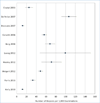Screening ultrasound as an adjunct to mammography in women with mammographically dense breasts
- PMID: 24959654
- PMCID: PMC4392403
- DOI: 10.1016/j.ajog.2014.06.048
Screening ultrasound as an adjunct to mammography in women with mammographically dense breasts
Abstract
There are potential benefits and harms of screening ultrasound (US) to supplement mammographic screening of women with dense breast tissue. We conducted a comprehensive literature review of studies assessing the efficacy of screening US to supplement mammography among women with dense breasts. From a total of 189 peer-reviewed publications on the performance of screening US, 12 studies were relevant to our analysis. The reporting of breast cancer risk factors varied across studies; however, the study populations tended to be at greater than average risk for developing breast cancer. Overall, US detected an additional 0.3-7.7 cancers per 1000 examinations (median, 4.2) and was associated with an additional 11.7-106.6 biopsies per 1000 examinations (median, 52.2). Significant improvements in cancer detection in dense breasts have been achieved with the transition from film to digital mammography. Thus adjunctive screening with ultrasound should be considered in the context of current screening mammography performance. Clinicians should discuss breast density as 1 of several important breast cancer risk factors, consider the potential harms of adjunctive screening, and arrive at a shared decision consistent with each woman's preferences and values.
Keywords: adjunctive screening; breast density legislation; dense breasts; screening breast ultrasound.
Copyright © 2015 Elsevier Inc. All rights reserved.
Conflict of interest statement
JRS, JML, CIL and CDL wish to disclose a research agreement with GE Healthcare on tomosynthesis and automated whole breast ultrasound; however, GE was not involved in any aspect of this study, including data analysis or manuscript preparation. BLS has no conflict of interest to report.
Figures


References
-
- Hall FM. Breast density legislation. Radiology. 2013;266(3):997–998. - PubMed
-
- Lee CI, Bassett LW, Lehman CD. Breast density legislation and opportunities for patient-centered outcomes research. Radiology. 2012;264(3):632–636. - PubMed
-
- Dehkordy SF, Carlos RC. Dense breast legislation in the United States: state of the States. Journal of the American College of Radiology : JACR. 2013;10(12):899–902. - PubMed
-
- Cappello NM. Decade of 'normal' mammography reports-the happygram. Journal of the American College of Radiology : JACR. 2013;10(12):903–908. - PubMed
-
- ACR. ACR BI-RADS® - Mammography. ACR Breast Imaging Reporting and Data System, Breast Imaging Atlas. Reston, VA: American College of Radiology; 2013;
Publication types
MeSH terms
Grants and funding
LinkOut - more resources
Full Text Sources
Other Literature Sources
Medical

